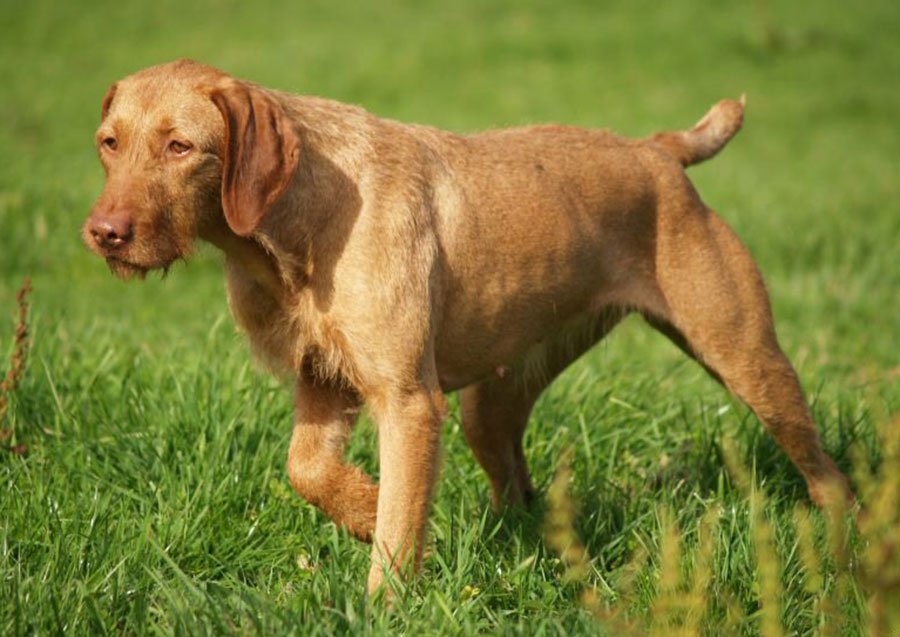Are you considering getting a new furry friend to add to your family? If you’re looking for a loyal, energetic, and affectionate companion, a Vizsla might be the perfect breed for you. Originally bred for hunting, Vizslas are intelligent, trainable, and thrive on human interaction. They are medium-sized dogs with a distinctive rust-colored coat and a muscular build. If you’re an active person who loves spending time outdoors, a Vizsla could be the perfect match for your lifestyle. However, before you make a decision, it’s important to learn more about this breed and their unique needs.
Breed Category: Gundog
Country of Origin: Hungary
Average Size:56-64 cm
Average Weight:20-30 kg
Average Life Span: 10-14 years
Grooming Requirements: Low
Exercise Requirements:High
History and Origin
The Vizsla is a breed of dog that originated in Hungary. It is a medium-sized dog that is known for its hunting abilities and its loyalty to its owners. The breed has a long history that dates back to the 10th century, and it has been used for hunting and as a companion dog for centuries.
The exact origin of the Vizsla is not known, but it is believed to have descended from the ancient Magyar hunting dogs that were used by the nomadic tribes of Hungary. These dogs were used for hunting game, such as deer, wild boar, and wolves. The Magyar tribes were known for their excellent horsemanship, and the Vizsla was often used as a hunting companion on horseback.
The Vizsla was first mentioned in written records in the 14th century, and it was described as a versatile hunting dog that was used for hunting birds, rabbits, and other small game. The breed was highly valued by the Hungarian nobility, and it was often given as a gift to foreign dignitaries. The Vizsla was also used as a guard dog and as a companion dog.
During the 16th and 17th centuries, the Vizsla was used extensively by Hungarian hunters, and it was considered one of the best hunting dogs in Europe. The breed was also used by the Hungarian army as a messenger dog during World War I. After the war, the breed almost became extinct due to the economic hardships faced by the Hungarian people. However, a group of dedicated breeders worked to save the breed, and it was eventually recognized by the Hungarian Kennel Club in 1925.
The Vizsla was first introduced to the United States in the 1950s, and it quickly gained popularity as a hunting dog and as a family pet. The breed was recognized by the American Kennel Club in 1960, and it is now one of the most popular hunting breeds in the United States. The Vizsla is also used as a therapy dog and as a search and rescue dog.
Today, the Vizsla is still used as a hunting dog in Hungary and other parts of Europe. The breed is also popular as a family pet due to its friendly and loyal nature. The Vizsla is an active dog that requires regular exercise and mental stimulation. It is also
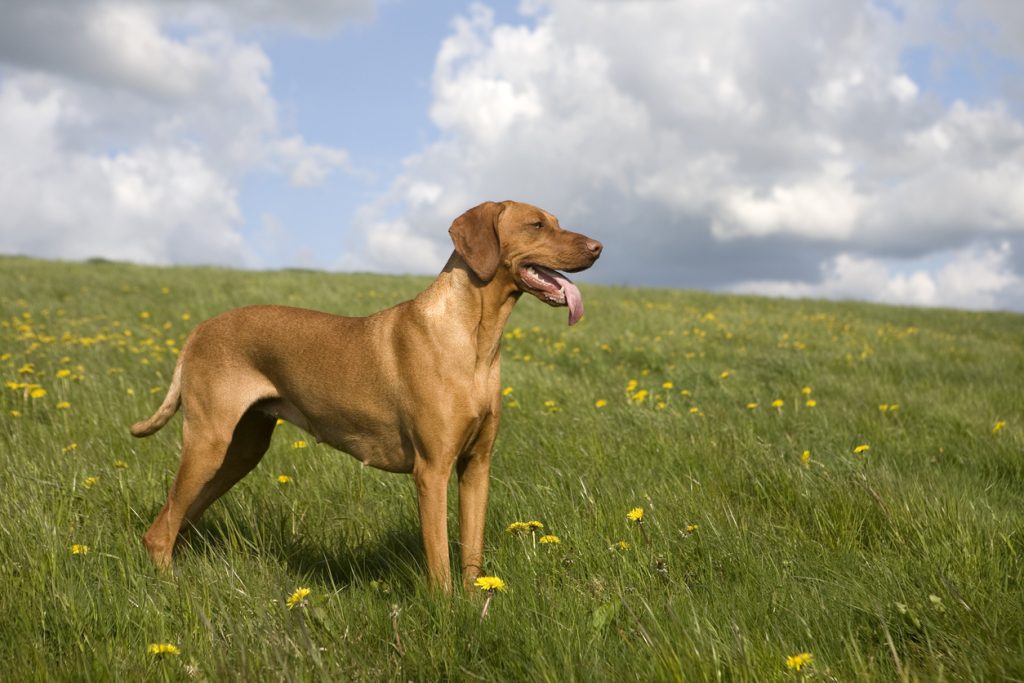
Size and Breed Category
The Vizsla is a medium-sized breed of dog that originated in Hungary. They are known for their athletic build and muscular physique, with a height range of 56-64cm and a weight range of 20-30kg. Their coat is short and dense, with a rust-colored hue that is unique to the breed. Vizslas have a distinctive appearance, with a long, narrow head and a sleek, streamlined body that is built for speed and agility. They are classified as a gundog breed, which means they were originally bred for hunting and retrieving game. Vizslas are highly energetic and require plenty of exercise and mental stimulation to keep them happy and healthy. They are also known for their loyalty and affectionate nature, making them a popular choice for families and active individuals.
In terms of breed category, the Vizsla is classified as a sporting dog. This means they are bred for hunting and retrieving game, and are typically used for activities such as field trials, hunting tests, and bird hunting. Vizslas are highly trainable and have a strong desire to please their owners, which makes them well-suited for these types of activities. They are also known for their excellent sense of smell and their ability to track and locate game in a variety of environments. In addition to their hunting abilities, Vizslas are also popular as family pets and companions. They are known for their affectionate and loyal nature, and are often described as “velcro dogs” because of their tendency to stick close to their owners. Overall, the Vizsla is a versatile breed that excels in a variety of roles, from hunting and retrieving to being a loving and devoted family pet.
Fur Length and Colour
The fur of a Vizsla is short and dense, with a smooth texture that lies close to the body. The fur is typically a rich golden rust color, with variations ranging from a lighter yellow to a darker mahogany. The fur on the ears and muzzle may be slightly darker than the rest of the body, and there may be small white markings on the chest and toes. The fur is easy to maintain and requires minimal grooming, with occasional brushing to remove loose hairs and keep the coat shiny and healthy.
The length of the fur on a Vizsla is uniform across the body, with no feathering or longer hair on the legs or tail. The fur is designed to protect the dog from the elements while hunting, providing insulation and protection from thorns and brush. The short fur also allows the Vizsla to move quickly and easily through dense cover, without getting tangled or caught. The color of the fur is an important characteristic of the breed, as it helps the dog blend in with its surroundings while hunting and provides a distinctive appearance that is easily recognizable.
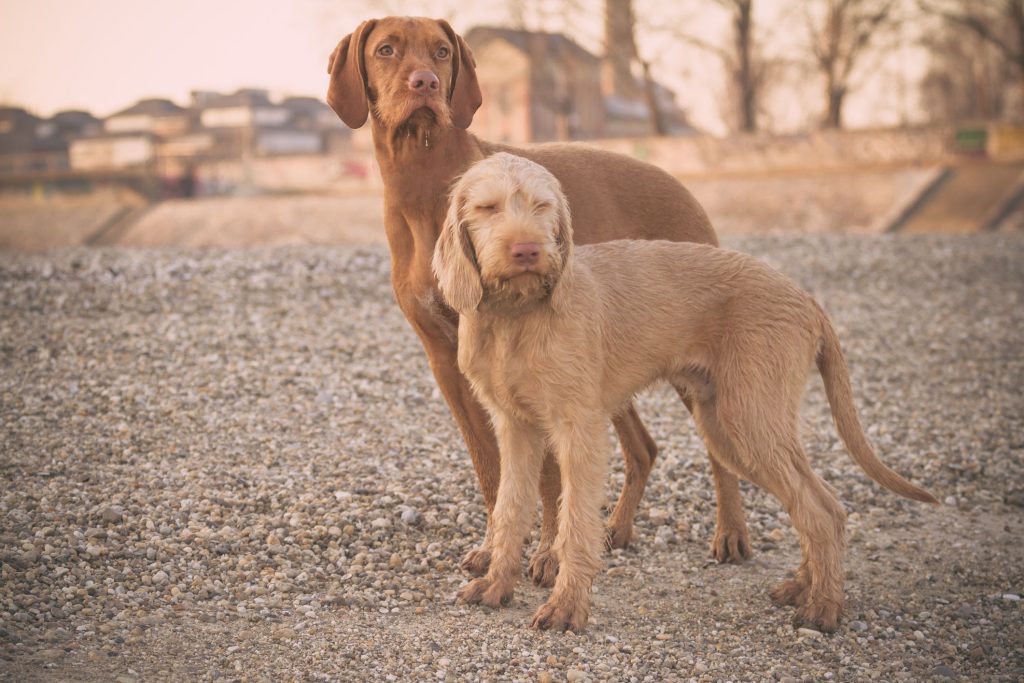
Termperament and Trainability
Vizslas are known for their high energy and lively temperament. They are a breed that thrives on human interaction and are very affectionate towards their owners. Vizslas are also very intelligent and have a strong desire to please their owners, making them highly trainable. However, their high energy levels can sometimes make them difficult to train, as they can become easily distracted and bored. It is important for Vizsla owners to provide them with plenty of mental and physical stimulation to keep them engaged and focused during training sessions. Overall, Vizslas are a great choice for active individuals or families who are willing to put in the time and effort to properly train and socialize them.
When it comes to trainability, Vizslas are a breed that responds well to positive reinforcement training methods. They are sensitive dogs and do not respond well to harsh or punitive training techniques. Vizslas are also very eager to please their owners, which can make them easy to train for basic obedience commands. However, they can be stubborn at times and may require a bit of patience and persistence from their owners. Vizslas are also highly trainable for activities such as agility, hunting, and tracking, as they have a strong natural instinct for these types of tasks. With proper training and socialization, Vizslas can make excellent companions for active individuals or families who are looking for a loyal and energetic dog.
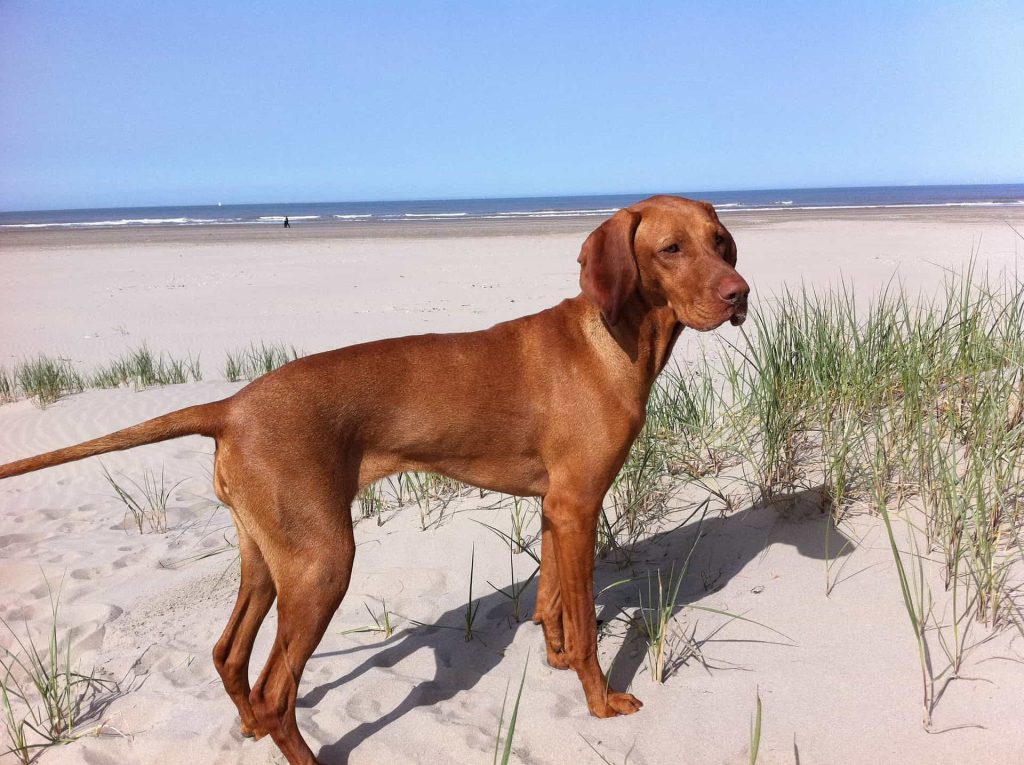
Known Health Conditions
Vizslas are a breed of dog that are known to be prone to certain health conditions. One of the most common health issues that Vizslas face is hip dysplasia. This is a condition where the hip joint does not develop properly, leading to pain and discomfort for the dog. Vizslas can also suffer from eye problems such as cataracts and progressive retinal atrophy, which can lead to blindness. Additionally, Vizslas are prone to skin allergies and ear infections, which can be caused by a variety of factors including diet, environmental allergens, and genetics. It is important for Vizsla owners to be aware of these potential health issues and to take steps to prevent and treat them as necessary.
Another health condition that Vizslas are susceptible to is epilepsy. This is a neurological disorder that can cause seizures and other symptoms such as confusion and disorientation. Vizslas can also develop a condition called hypothyroidism, which occurs when the thyroid gland does not produce enough hormones. This can lead to a range of symptoms including weight gain, lethargy, and skin problems. Finally, Vizslas are at risk for a type of cancer called hemangiosarcoma, which affects the blood vessels and can be difficult to treat. Regular veterinary check-ups and preventative care can help to identify and manage these health conditions in Vizslas.
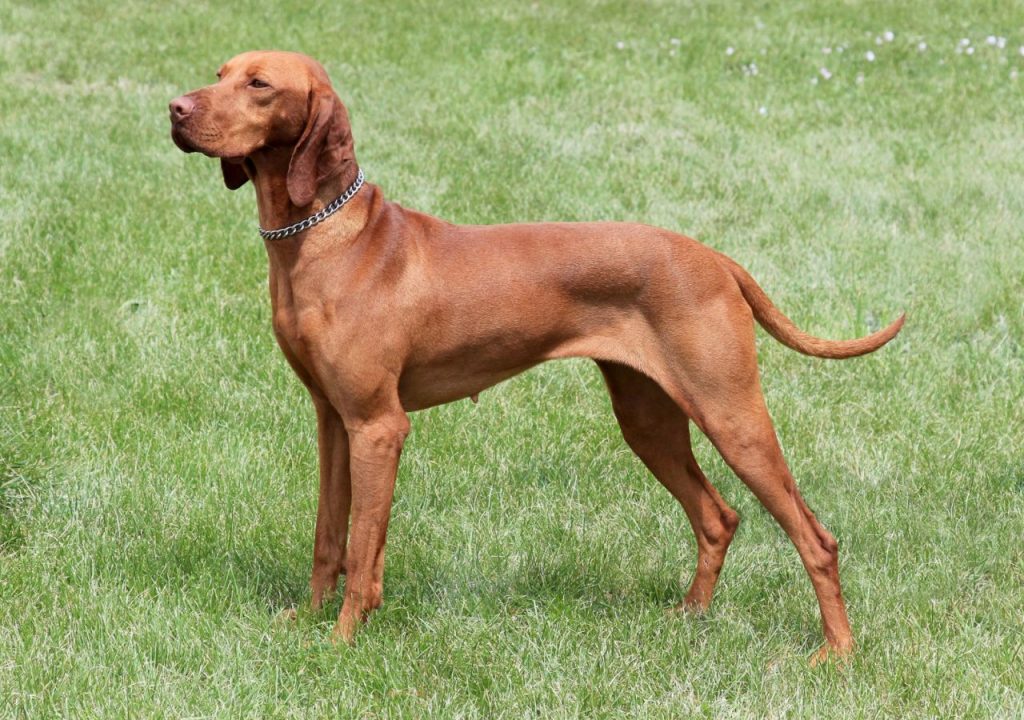
Openness to Strangers
Vizslas have a reputation for being friendly and sociable with strangers. They are known to be outgoing and approachable, often seeking attention and affection from anyone who is willing to give it. This trait makes them popular as family pets and companions, as they are always eager to make new friends and form strong bonds with their owners. Vizslas are also highly adaptable and can thrive in a variety of environments, from busy city streets to quiet rural areas. Their open and friendly nature makes them a great choice for families with children or other pets, as they are generally very tolerant and patient.
Despite their friendly nature, Vizslas can be quite protective of their owners and their territory. They are known to be alert and watchful, and will often bark to alert their owners of any potential threats. However, they are not typically aggressive towards strangers, and will usually only bark as a warning. Vizslas are also highly intelligent and trainable, and can be taught to be more reserved or cautious around strangers if necessary. Overall, their openness to strangers makes them a great choice for anyone looking for a friendly and sociable companion, but it is important to remember that they still require proper training and socialization to ensure that they are well-behaved and well-adjusted.
Playfulness Level
The Vizsla is a highly energetic and playful breed of dog. They are known for their love of play and their ability to keep up with even the most active of owners. With their high energy levels and love of exercise, the Vizsla is the perfect companion for those who enjoy outdoor activities such as hiking, running, and swimming. They are also highly intelligent and enjoy mental stimulation, making them great candidates for training and agility competitions.
The playful nature of the Vizsla extends beyond their love of physical activity. They are also known for their affectionate and loyal personalities, making them great family pets. They thrive on human interaction and enjoy spending time with their owners, whether it be playing fetch in the backyard or cuddling up on the couch. Their playful nature and love of attention make them great with children, as they are patient and gentle with little ones. Overall, the Vizsla is a fun-loving and playful breed that is sure to bring joy and energy to any household.
Suitability as a Pet for Children
Vizslas are a highly energetic and affectionate breed, making them a great choice for families with children who are active and enjoy spending time outdoors. They are known for their loyalty and love to be around their owners, often following them from room to room. Vizslas require a lot of exercise and mental stimulation, so they are best suited to families who have the time and energy to provide them with plenty of playtime and training. They are also very intelligent and respond well to positive reinforcement, making them easy to train. Overall, Vizslas can make wonderful pets for families with children who are willing to put in the time and effort to meet their needs.
Exercise Needs
Vizslas are highly energetic dogs that require a lot of exercise to stay healthy and happy. They are known for their athleticism and love of running, making them great companions for active individuals or families. A daily walk is not enough for this breed, as they need at least an hour of vigorous exercise each day to burn off their excess energy. This can include activities such as running, hiking, swimming, or playing fetch. Vizslas also enjoy participating in dog sports such as agility, obedience, and tracking. It is important to note that Vizslas are not well-suited for apartment living or sedentary lifestyles, as they can become destructive and develop behavioral issues if they do not receive enough exercise.
In addition to physical exercise, Vizslas also require mental stimulation to prevent boredom and destructive behavior. They are intelligent dogs that thrive on learning new things and solving puzzles. Training sessions and interactive toys can provide mental stimulation for this breed. Vizslas also enjoy spending time with their owners and can become anxious or depressed if left alone for long periods of time. It is important for owners to provide plenty of socialization and attention to their Vizslas to keep them happy and well-adjusted. Overall, Vizslas are a high-energy breed that require both physical and mental exercise to stay healthy and happy.
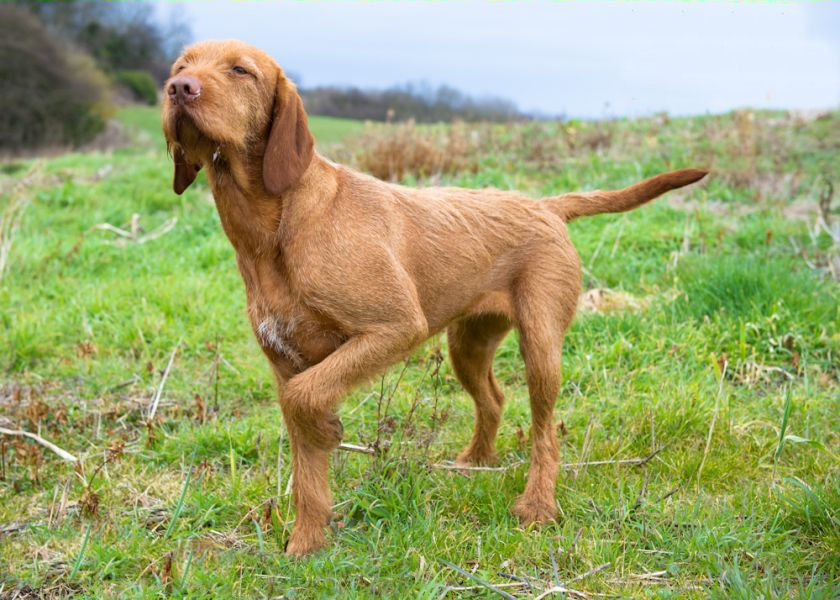
Suitability for a Multi-Pet Family
Vizslas have a reputation for being friendly and sociable animals. They are known to be good with children and often make great family pets. When it comes to other pets, Vizslas can generally get along well with other animals in the household. However, as with any breed, it is important to introduce them to other pets slowly and carefully to ensure a positive relationship. With proper socialization and training, Vizslas can coexist peacefully with other pets in the home.
Housing Requirements
Vizslas require a spacious living environment that allows them to move around freely. They are an active breed that needs plenty of exercise, so a house with a large garden or access to open spaces is ideal. The garden should be securely fenced to prevent the Vizsla from escaping, as they are known to be skilled escape artists. Additionally, Vizslas are sensitive to extreme temperatures, so their living environment should be well-insulated and provide adequate heating during colder months. It is important to note that Vizslas are social animals and thrive on human interaction, so their living environment should be located in an area where they can be included in family activities.
Vizslas require a comfortable sleeping area that is warm and dry. A soft bed or blanket is recommended to provide them with a cozy sleeping space. As a breed that sheds moderately, it is important to keep their sleeping area clean and free of hair. Vizslas are also prone to separation anxiety, so it is recommended that their sleeping area is located in a quiet part of the house where they can feel safe and secure. Additionally, Vizslas are known to be clean animals and require regular grooming to maintain their coat. A designated grooming area with a table and appropriate grooming tools is recommended to keep their coat in good condition.
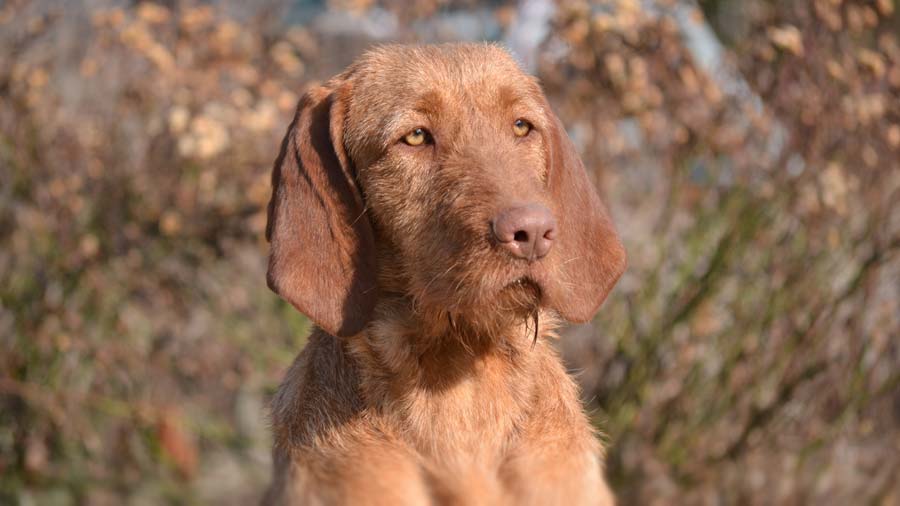
Summary
Vizslas have a high energy level and require plenty of exercise and mental stimulation. They are intelligent and trainable, making them suitable for owners who are willing to put in the time and effort to train them properly. They are affectionate and loyal to their owners, but may be reserved with strangers. Vizslas may not be suitable for households with small children or other pets, as they have a strong prey drive. Overall, Vizslas can make great pets for active and dedicated owners who are able to provide them with the exercise and attention they need.
Vizsla, short-haired and wire-haired Dog FAQS
Vizslas are intelligent and eager to please, making them relatively easy to train.
Yes, Vizslas are generally good with children and make great family pets.
Vizslas are active dogs and require a lot of exercise, so they are not well-suited for apartment living. They need a large yard or access to open spaces to run and play.
Vizslas are prone to hip dysplasia, epilepsy, and eye problems. Regular vet check-ups can help detect and manage these issues.
Yes, Vizslas shed moderately and require regular grooming to maintain their coat.
Vizslas have a lifespan of 10-14 years on average.
Vizslas are high-energy dogs and require at least 1-2 hours of exercise per day.
The amount of food depends on the age, weight, and activity level of the dog. Generally, Vizslas require 2-3 cups of high-quality dog food per day.
Vizslas should have regular check-ups with a vet at least once a year.
The average weight of a Vizsla is between 20-30 kg.
